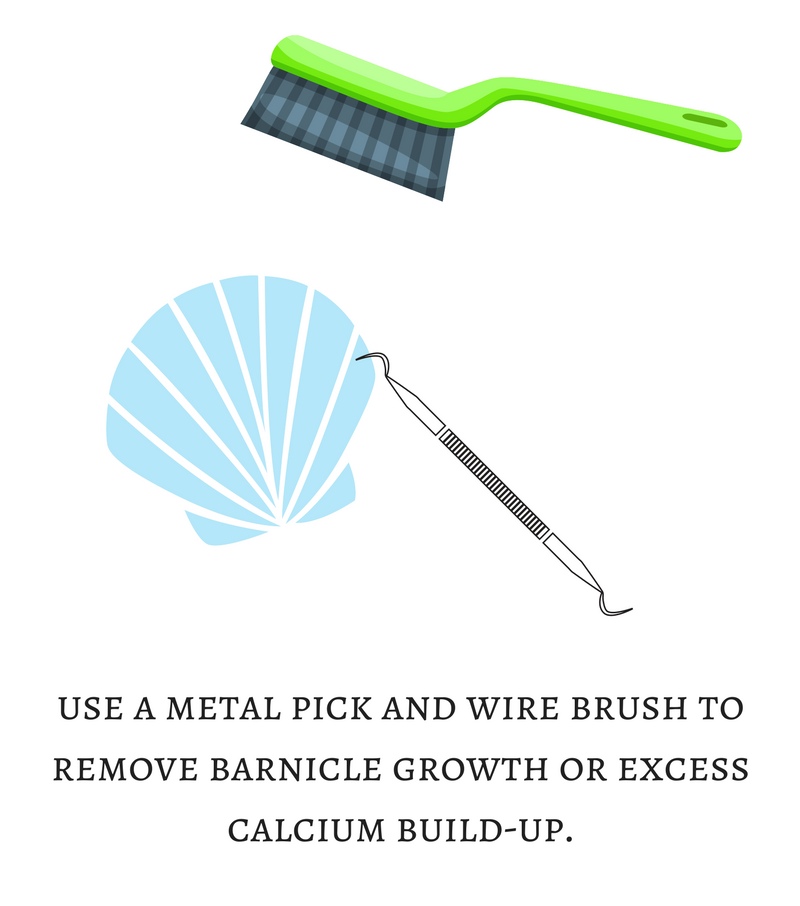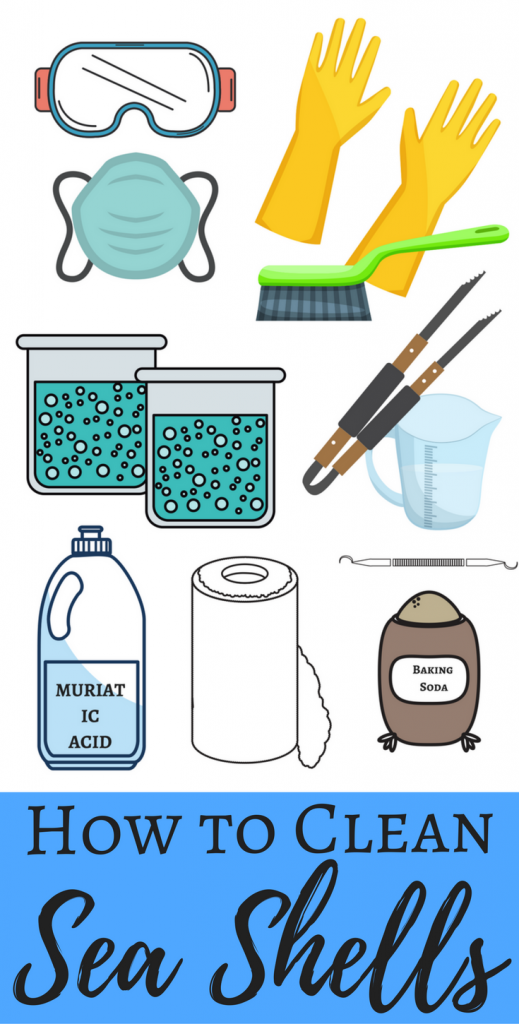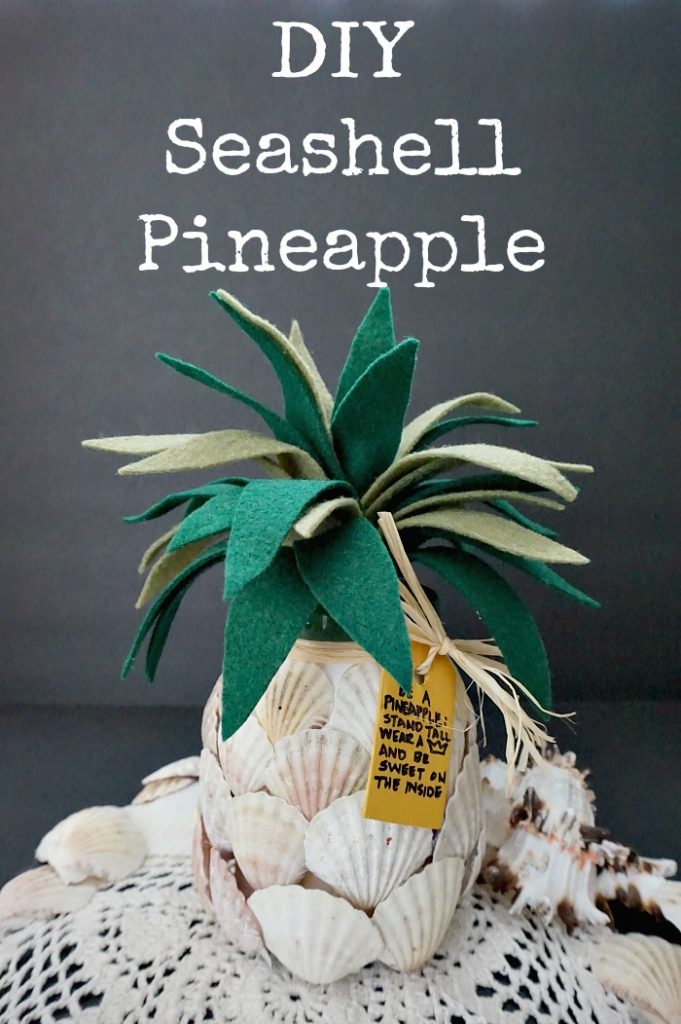Warning: As with any chemical solutions, this should only be done by adults in a well-ventilated area. Proper safety apparel should be worn at all times. Cleaning shells using muriatic acid can be dangerous, so do at your own risk.
Recently, I’ve started to decorate with a lot of seashells and wanted to learn how to clean them. So, like most people, I scoured the internet to learn how to clean all the gunk and calcium build-up on shells. I found that there are two common ways to clean seashells, bleach or muriatic acid, but not a lot of people discussed how to dispose of the acid solution. So today, I’m going to share how to clean seashells with muriatic acid solution AND how to neutralize and dispose of it.


Supplies for Cleaning Shells
- safety googles– It’s important to protect your eyes from any liquid that may be splashed, so please wear safety goggles.
- rubber gloves– Protect your skin and wear gloves when working with muriatic acid.
- respiratory mask– Recommend protecting your lungs from any fumes.
- muriatic acid (buy at Lowes or Home Depot for around $8)
- water
- tongs
- glass bottles (I used large glass vases)
- glass measuring cup (do not reuse for food)
- baking soda or lime
- paper towels/towel
- metal pick (optional)
- metal scrub brush (optional)
- large plastic bucket or tub for acid-neutralizing
Before starting, here are a few precautions:
- DO NOT do this indoors or near anything that is stainless steel as it can discolor the metal.
- DO NOT allow children to do this or be anywhere near you while doing this.
- Make sure you have all the proper safety equipment on BEFORE and DURING the shell cleaning process as the acid can burn the skin. If any acid gets on the skin, immediately wash off with water.
- Have water and a large box of baking soda or lime ready to neutralize the acid in case of any accidental spills.
How to Clean Seashells with Muriatic Acid Solution
- In a large glass bottle, add 3/4 cup water and then 1/4 cup of the acid (always add water and then the concentrated acid).
- Fill another bottle with just water.
- Use the tongs and dip one shell at a time into the muriatic solution for about 3-seconds. You will see “fizzing” as the acid attacks the calcium build-up on the seashells. Leaving the shells in longer than 3-seconds can compromise the shell and color.
- Immediately dip the seashell into the water to rinse and place on a towel to dry.
- If seashells still have growths or large white calcium build-up on them, softly scrub with a wire brush or use a metal pick to scrap it off.
How to Neutralize and Dispose of the Muriatic Acid
DO NOT dump the muriatic acid solution down your drain or into the sewer system without neutralizing it first. To neutralize the solution, add water and baking soda or lime to another large container and slowly add the muriatic solution. Alternate between the baking soda and muriatic solution until there is no “fizzing”. Once there is no more fizzing, it should be safe to dispose of.
If you have other ways to clean seashells, I would love to hear about them in the comments below.
Seashell Crafts ~
Giant DIY Seashell Seahorse Art
DIY Seashell Pineapple JarDIY Aloha Seashell Pineapple Sign













Hi everyone. Nice to see some help for people that might like to enhance the seashells they collect. I use muriatic acid (dilute HCl) to clean the outer layers off rainbow kelp shells and expose the colourful nacreous layer underneath. The only comment I would make to these instructions is with regard to disposal of the acid solution. Given that you’re only likely to use up to 200 ml of acid solution, and it’s diluted, I suggest just pouring it into the middle of a gravel driveway, or similar safe place. Then just forget about it. The acid will quickly be neutralised by reaction with the gravel (I’m a retired geologist so I know about rocks). This is easier and safer than trying to neutralise it with baking soda and pouring it down a drain.
Great tip. Thanks for letting me know. I have a ton of gravel in the the yard.
Just a word of cuation…
Your current wording of “always add water and then the concentrated acid” could lead some hasty readers to see just the first part of the sentence and do exactly the opposite of what is safe.
To be less ambiguous, you might want to rephrase that sentence as “Always Add Acid to Water.” It is known in science classes as the ‘Triple-A rule.’ Alternatively, you could change the first ‘add’ to ‘start with’…
Please tell me how to clean and polish green limpet shells. One side is a beautiful blue-green and shiny. The other side is rough like a clam shell.
Thanks for any and all suggestions!
Hi Mitzi, I’ve never cleaned a limpet, but check out this video on YT for an abalone shell. I think you might be able to use the same technique with limpets. https://www.youtube.com/watch?v=1_1qzy5pMKg
What tongs do you use? Type of metal or?
I used metal tongs.
Yes this process of muriatic acid for 3 seconds works very well for crusty shells.
Just be EXTREMELY CAREFUL not to spill or splash the acid.
Of course as stated DO NOT dump the muriatic acid down your sink. Actually I keep the acid in a large glass jar with a tight cover – like a pasta sauce jar – and I mark the jar with “CAUTION – ACID FOR CLEANING SEASHELLS”. Keep it on a high shelf in the garage. It can be reused for a long time – each time I go to the beach I always find a few shells that need to be dipped. Just be very careful using muriatic acid. Note: don’t use this acid dip on shiny shells – it will etch and dull the shine.
Non crusty shells that just need a good cleaning – I boil them in a pot used only for shell cleaning. I add one tablespoon of bleach to the pot of water and boil for a few minutes.
HAPPY SHELLING!
I honestly only ever rinsed off the shells with a bit of soap and water so this is fascinating! Thanks so much for sharing at the Summer Time Fun Linky. Pinned.
How do you dispose of solution once it is neutralized? Is it safe to dispose in sink?
I don’t use it in the house, but once it’s neutralized I dispose of it in our outside drain.
Was wondering if anyone has used “green” muriatic acid. Thank you
I haven’t tried using ‘green’ muriatic acid, but it looks like the same thing with less fumes so I think it should work fine. I really only use it on shells with heavy calcium build up and those that look a little dull. Otherwise, I try to just scrub the shells with a soft brush.
Wow the shells look great after doing this! Love that Seahorse pic too! Pinned & sharing on FB & Twitter
Kim